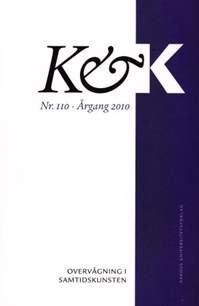PARANOID, MOI? – ERASING DAVID
DOI:
https://doi.org/10.7146/kok.v38i110.15774Nøgleord:
overvågning, filmdokumentar, videoovervågning, Ferguson, Leitner, Erasing David, paranoiaResumé
PARANOID, MOI? – ERASING DAVID
The article discusses the relationship between the subject of surveillance and documentary film. As its main example, it uses David Bond’s Erasing David from 2009, which thematically revolves this particular topic, the British surveillance society (Big Brother Britain). The genre-specific and film historic aspects of this documentary are analysed and in a further perspective serve as the point of departure for a more general theoretical discussion of surveillance.
Through the treatment of its content and the conceptual framework, Bond’s film places itself within what could appropriately be termed the “popular cultural documentary”. What characterises this part of the genre is a critical approach bordering on activism. This is sought, combined with the ability to entertain the audience, through elements of fiction and comic relief while attempting an analysis of a current and often controversial subject. Michael Moore’s productions are the most successful examples of this filmmaking strategy, and two film analytical approaches based on Moore’s 1989 debut Roger & Me are used to evaluate the aesthetic and conceptual coherence in Bond’s work.
Following this, a three-part taxonomy for the analytical and normative understanding of the surveillance phenomenon and its socio-cultural and political implications is established. These are termed: The critical-subversive, the para-cultural and the affirmative mode of understanding. The critical-subversive mode is comparable to the expository documentary form. A strategy that, regardless of it is being articulated academically or aesthetically, aims at the disclosure of hidden societal mechanisms by way of facts. In a theoretical perspective, this is discussed in relation to Foucault’s idea of the ‘panopticon’ and more recently Bruno Latour’s corrective counter-concept ‘oligopticon’. The para-cultural intervention is akin to Michel de Certeau’s understanding of ‘creative re-appropriation’ and ‘making do’. This tactic, like the previous one, is generally speaking sceptical of a surveillance society and its implications, though it establishes a different, temporary form of critical stanza.
The last mode of portraying and analyzing surveillance is termed affirmative. This is directly connected to the popular cultural representation of surveillance tech nologies. According to the German art historian O.K. Werkmeister, these tech nologies are here ascribed an almost omnipresent and omniscient potential. Regardles of the fact that these images of surveillance tech nologies and their capabilities often seem rather counterfactual, they nonetheless participate in creating an internalisation of the surveillance culture, one which is paradoxically endorsed by both its supporters and critics, among these David Bond.
Both the theoretical perspective and the film analytical approach to Bond’s film discuss problematic weaknesses in his project. Bond tends to invest more in cracking the ‘formula’ for a successful presentation of his material, than discovering new formalistic or analytical territory in the filmic exposure of current surveillance culture.
Downloads
Publiceret
Citation/Eksport
Nummer
Sektion
Licens
Tidsskriftet følger dansk ophavsret.





